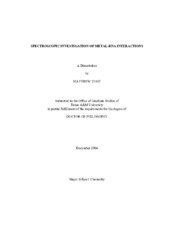Spectroscopic investigation of metal-RNA interactions
Abstract
Metal-RNA interactions are important to neutralize the negative charge and aid in correctly folding the RNA. Spectroscopically active metal ions, especially Mn2+, have been used to probe the type of interaction the metal has with RNA. In previous studies, the hammerhead ribozyme, an RNA motif that catalyzes a site-specific phosphodiester bond cleavage reaction, was determined by room temperature EPR (electron paramagnetic resonance) studies to have a set of tightly and weakly bound metal ions. Under high salt concentrations, the hammerhead was found to bind a single Mn2+ ion with high affinity and with a characteristic low temperature EPR signal.
Using site specific 15N labeling of a guanine residue in conjunction with ESEEM (electron spin echo envelope modulation) spectroscopy, the high affinity Mn2+ ion was conclusively determined coordinated to G10.1 of the proposed A9/G10.1 site with four water molecules coordinated to the Mn2+ ion. EPR power saturation studies determined that under low salt conditions the hammerhead coordinates up to four Mn2+ ions in relatively close proximity compared to an RNA duplex.
EXAFS (extended X-ray absorption fine structure) spectroscopy was used to determine that a Cd2+ ion coordinates to both the Rp and Sp sulfur atoms of a phosphorothioate modification at the A9 phosphate of the hammerhead. Previous EXAFS results for the Mn2+ substituted A9 phosphorothioate suggested that the Mn2+ ion coordinates to the oxygen atom for both isomers. Molecular modeling suggested that the A9/G10.1 metal site will twist the phosphate group in order to accommodate this coordination. A Mn-GMP and Mn-phosphate model complexes were prepared and characterized by EXAFS to assign the origin of the features observed for the hammerhead sample.
A series of RNA sequences with internal loops containing the sheared G-A metal ion binding motif showed greater thermal stabilization of the RNA structure in the presence of Mn2+ ions compared to sequences without the motif. The EPR binding isotherms also showed a set of moderately tight metal ion interaction while circular dichroism spectroscopy was used to investigate structural differences between the sequences. These results suggest a mostly electrostatic, not structural role, for the Mn2+ ion interactions with these sequences.
Citation
Vogt, Matthew John (2004). Spectroscopic investigation of metal-RNA interactions. Doctoral dissertation, Texas A&M University. Texas A&M University. Available electronically from https : / /hdl .handle .net /1969 .1 /1344.


